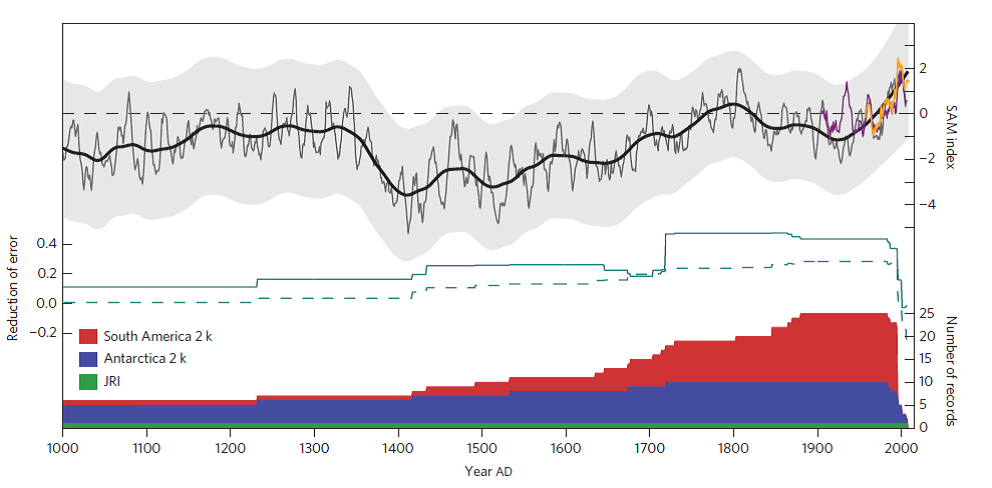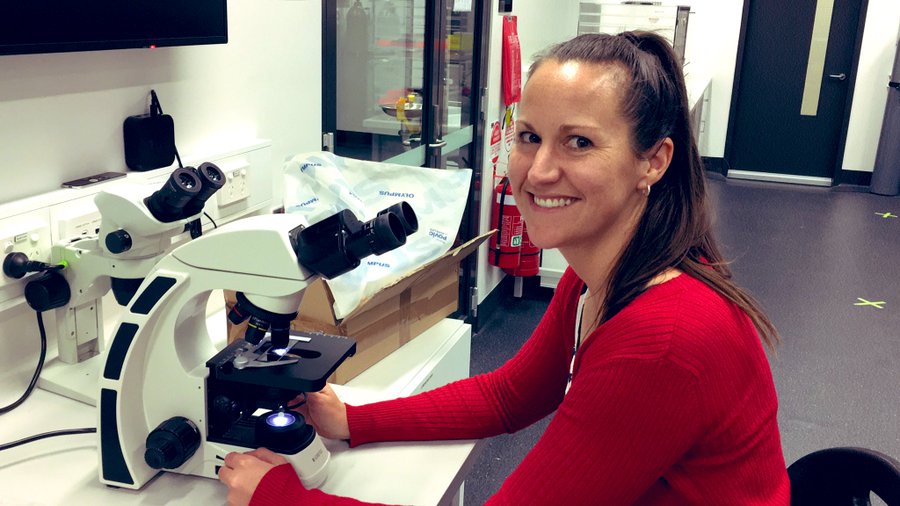By Ignacio A. Jara
The Southern Annular (SAM) mode is one of the most important atmospheric phenomenon affecting temperature and precipitation in the non-tropical Southern Hemisphere. Perhaps the clearest sign of its growing importance for the scientific community was the mention of SAM in several talks in the SHAPE session in the AQUA biennial conference here in Mildura.
A tendency toward positive SAM polarity over the last couple of decades is expressed as an overall poleward contraction and intensification of the cold and rain-carrying Southern Westerly Winds. In regions exposed to westerly activity such as southern Australia, New Zealand and southern South America this dynamic has resulted in a significant reduction in precipitation and an overall increase in temperatures. On the other hand, positive SAM has a mixed influence on Antarctic temperatures. While most of eastern Antarctica has experienced cooling over the positive SAM timeframe, some areas of western Antarctica and most of the Antarctic Peninsula have been warming over the same period. The Antarctic Peninsula seems to be critical in terms of future SAM variability since it represents the transitional area between the warming continental Southern Hemisphere and the cooling east Antarctica. Thus, the Antarctic Peninsula was the focus of a group of researchers who have published a late Holocene SAM reconstruction now available online in the journal Nature Climate change1.
This new article presents a composite reconstruction using temperature records from the whole domain of SAM influence: South America, the Peninsula and the main Antarctic continent; modelling its evolution over the last millennium. Negative SAM characterizes the first interval of the reconstruction, followed by two positive excursions between 1400 and 1800 AD and during the 20th century respectively. Furthermore, the authors evaluate potential SAM drivers through a series of modelling simulations and suggest that the first positive SAM pulse can be explained by an increase in the solar irradiance; whereas the latest 20th century positive excursion fails to be replicated by any radiative forcing, it is only fully reproduced by the models when greenhouse gas forcing is added.
El Nino Southern Oscillation and SAM
Another natural SAM forcing explored in the article is tropical climate variability. Instrumental climate data indicates that La Niña years correlate with positive SAM, with evidence of warm conditions in the Antarctic Peninsula and New Zealand2. By comparing their new SAM reconstruction with a highly resolved proxy for ENSO variability, the authors found this correlation operated throughout the last millennium. For instance, the dominance of El Niño conditions during the first part of the millennia seem to have acted as a negative driver for SAM; while the first positive SAM pulse coincides with a tendency towards more La Niña conditions. Critically, this long term correlation breaks down in the 20th century when the latest positive trend of SAM parallels an increase in El Niño, suggesting that the tropical Pacific in its El Niño state is currently not muting or attenuating the positive SAM trend (ENSO was covered in the previous blog 10). Figure 1: SAM reconstruction for the past millennium relative to the average during 1961-1990 average (dashed black line). Figure from reference 1.
Figure 1: SAM reconstruction for the past millennium relative to the average during 1961-1990 average (dashed black line). Figure from reference 1.
SAM and rainfall changes in Australia
Another interesting new publication has compared Australian precipitation variability with ENSO and SAM over the last few decades3. This new article shows a reduction in winter precipitation in the coastal areas of southern Australia by 10-20% since 1970; while summer precipitation in the dry inland and northern areas has increased from 40 to 50%. Interestingly, the authors correlated the reduction of winter precipitation with fewer and weaker westerly fronts, a phenomenon largely documented as occurring during positive SAM. On the other hand, enhanced easterly fronts over the north and the central areas have brought more tropical precipitation, especially during summer to northern areas.
Figure 2: Map depicting rainfall changes in Australia in the period 1997-2009 compared with the 20th century average. Precipitation in South eastern Australia have been significantly reduced over the last decades as result of the southward migration of the westerly storms, due to the positive trend in SAM. Figure from reference 5.
As south eastern Australia -the most populated and industrialised portion of the country- relies significantly on the westerly winds as its main precipitation source, a better knowledge of the future SAM trends will be critical for better estimates of water availability over the next few decades. If the positive trend of SAM continues under future global warming scenarios, river runoff in places such as Mildura (the location of the current AQUA conference) will surely be severely compromised unless that summer tropical precipitation fronts extend further south. However, models of future SAM projections are not completely clear. The slow recovery of the Ozone layer seems to be forcing SAM to a negative phase4. More research to understand the potential future of SAM under future climate change, along with adaptation and mitigation programs will be critical for the wellbeing of the Australian community.
Reference
- Abram, N. J., Mulvaney, R., Vimeux, F., Phipps, S. J., Turner, J., England, M. H. (2014). Nature Climate Change 4, 564–569.
- Fogt R.. L., Bromwish, D. H., Hines, K. M. (2011). Climate Dynamics 36, 1555–1576
- Raut, B., C. Jakob, and M. Reeder. (2014). Rainfall Changes over Southwestern Australia and their Relationship to the Southern Annular Mode and ENSO. Journal of Climate. In press.doi: http://dx.doi.org/10.1175/JCLI-D-13-00773.1
- D. W. J. Thompson, S. Solomon, P. J. Kushner, M. H. England, K. M. Grise, D. J. Karoly, Signatures of the Antarctic ozone hole in Southern Hemisphere surface climate change. Nature Geosci 4, 741-749 (2011).
- Post, D. A., Bertrand, T., Chiew, H. S., Hendon, H., H. Nguyen, H., Moran, R. (2014). Decrease in southeastern Australia water availability linked to ongoing Hadley cell expansion. Earth´s future, 2, 231-238

